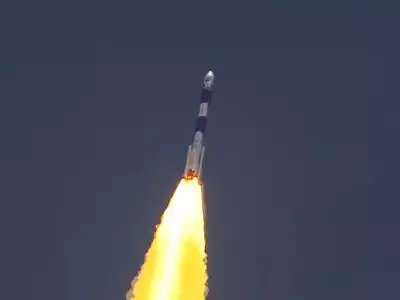The Aditya Solar wind Particle Experiment (ASPEX) payload onboard India’s Aditya-L1 satellite has commenced its operations and is performing normally.
Basically, ASPEX comprises two cutting-edge instruments – the Solar wind Ion Spectrometer (SWIS) and STEPS (Supra Thermal and Energetic Particle Spectrometer).
The STEPS instrument was operational on September 10, 2023.
Also, the SWIS instrument was activated on November 2, 2023, and has exhibited optimal performance.
SWIS, utilizing two sensor units with a remarkable 360° field of view each, operates in planes perpendicular to one another.
The instrument has successfully measured solar wind ions, primarily protons and alpha particles.
A sample energy histogram acquired from one of the sensors over two days in November 2023 illustrates variations in proton (H+) and alpha particle (doubly ionized helium, He2+) counts.
These variations were recorded with nominal integration time, providing a comprehensive snapshot of solar wind behaviour.
The directional capabilities of SWIS enable precise measurements of solar wind protons and alphas, contributing significantly to addressing longstanding questions about solar wind properties, underlying processes, and their impact on Earth.
The change in the proton and alpha particle number ratio, as observed by SWIS, holds the potential to provide indirect information about the arrival of Coronal Mass Ejections (CMEs) at the Sun-Earth Lagrange Point L1.
Enhanced alpha-to-proton ratio is often regarded as one of the sensitive markers of the passage of interplanetary coronal mass ejections (ICMEs) at the L1 and hence considered crucial for space weather studies.
As researchers delve deeper into the collected data, the international scientific community eagerly awaits the wealth of knowledge that Aditya-L1’s ASPEX is set to unveil about the enigmatic solar wind and its implications for our planet.
About Aditya L-1 Satellite
Aditya-L1 is a satellite dedicated to the comprehensive study of the Sun.
It has 7 distinct payloads developed, all developed indigenously.
Five by ISRO and two by Indian academic institutes in collaboration with ISRO.
Aditya in Sanskrit means the Sun. L1 here refers to Lagrange Point 1 of the Sun-Earth system.
For common understanding, L1 is a location in space where the gravitational forces of two celestial bodies, such as the Sun and Earth, are in equilibrium.
This allows an object placed there to remain relatively stable with respect to both celestial bodies.
Following its scheduled launch on September 2, 2023, Aditya-L1 stays Earth-bound orbits for 16 days, during which it undergoes 5 maneuvres to gain the necessary velocity for its journey.
Subsequently, Aditya-L1 undergoes a Trans-Lagrangian1 insertion maneuvre, marking the beginning of its 110-day trajectory to the destination around the L1 Lagrange point.
Upon arrival at the L1 point, another maneuvre binds Aditya-L1 to an orbit around L1, a balanced gravitational location between the Earth and the Sun.
The satellite spends its whole mission life orbiting around L1 in an irregularly shaped orbit in a plane roughly perpendicular to the line joining the Earth and the Sun.
The strategic placement at the L1 Lagrange point ensures that Aditya-L1 can maintain a constant, uninterrupted view of the Sun.
This location also allows the satellite to access solar radiation and magnetic storms before they are influenced by Earth’s magnetic field and atmosphere.
Additionally, the L1 point’s gravitational stability minimizes the need for frequent orbital maintenance efforts, optimizing the satellite’s operational efficiency.
Quick Facts: Aditya-L1 will stay approximately 1.5 million km away from Earth, directed towards the Sun, which is about 1% of the Earth-Sun distance.
The Sun is a giant sphere of gas and Aditya-L1 would study the outer atmosphere of the Sun. Aditya-L1 will neither land on the Sun nor approach the Sun any closer.
Source: https://www.isro.gov.in/





